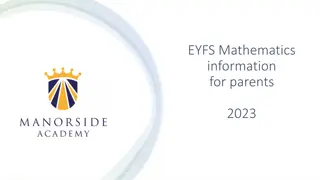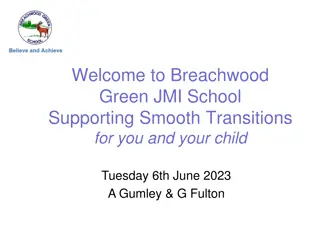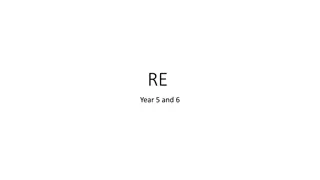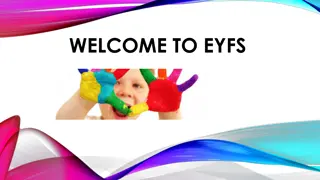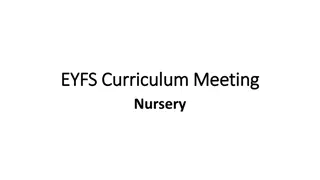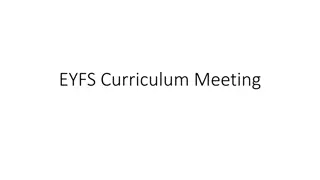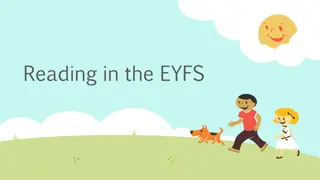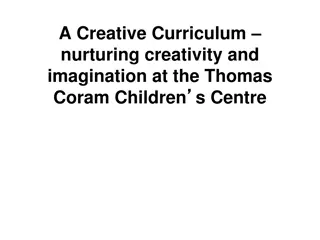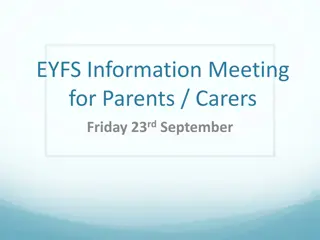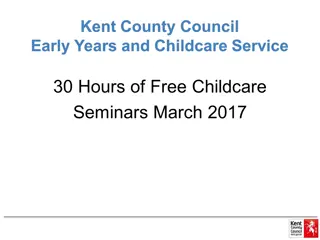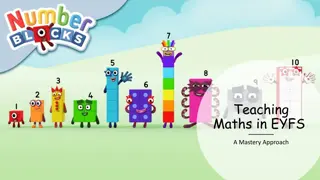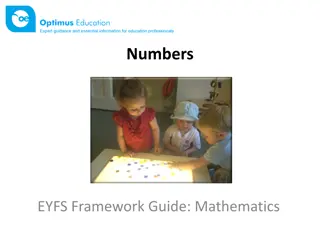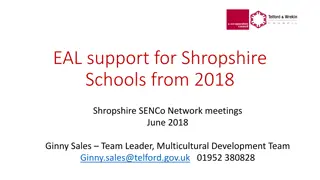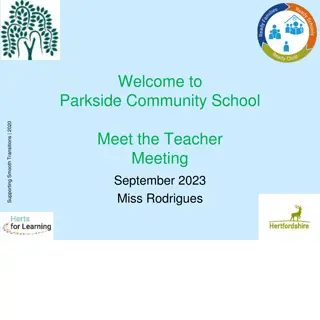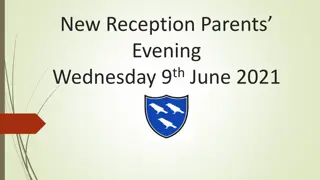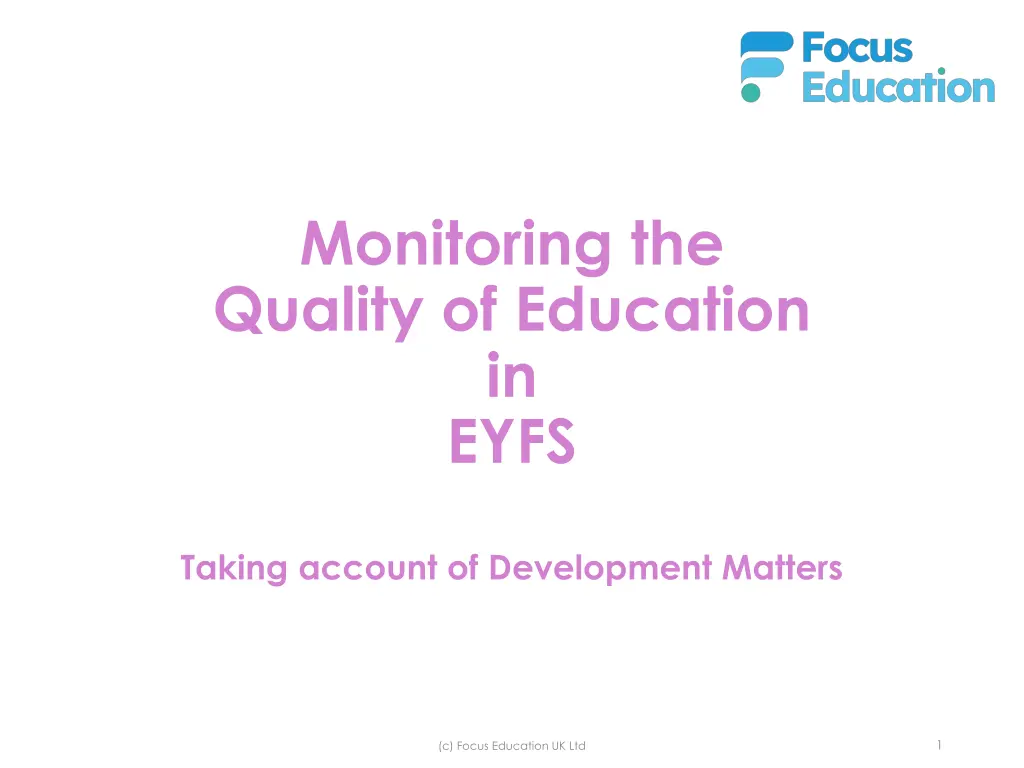
Monitoring Quality of Education in EYFS Development Matters
Explore the progress of Communication and Language skills in Early Years Foundation Stage (EYFS) children, focusing on listening, attention, and understanding. Track development milestones from Nursery to Reception stages and learn about expected levels of comprehension and engagement at each term.
Download Presentation

Please find below an Image/Link to download the presentation.
The content on the website is provided AS IS for your information and personal use only. It may not be sold, licensed, or shared on other websites without obtaining consent from the author. If you encounter any issues during the download, it is possible that the publisher has removed the file from their server.
You are allowed to download the files provided on this website for personal or commercial use, subject to the condition that they are used lawfully. All files are the property of their respective owners.
The content on the website is provided AS IS for your information and personal use only. It may not be sold, licensed, or shared on other websites without obtaining consent from the author.
E N D
Presentation Transcript
Monitoring the Quality of Education in EYFS Taking account of Development Matters 1 (c) Focus Education UK Ltd
COMMUNICATION AND LANGUAGE: Progress through Nursery/FS1 Listening, attention and understanding Baseline Nursery/FS1 End of autumn term End of spring term End of Nursery/FS1 Children should be working at a level which sees them: Children should be working at a level which sees them: Children working at the expected level of development will Children should be working at a level which sees them: Enjoy listening to longer storiesand can remember much of what happens. Focusing attention still listen or do, but can shift own attention; Understand a question or instruction that has two parts Shows a growing understanding of prepositions such as under , on top , by carrying out an action or selecting correct picture Understand why questions Sing a large repertoire of songs. Know many rhymes, be able to talk about familiar books, and be able to tell a long story. Listening and following directions and looking at someone when they are speaking; Using prepositions when following instructions; Asking and responding to why questions; Following stories read to them and talk about the pictures in the book. Listen to simple stories and understand what is happening, with the help of the pictures. Identify familiar objects and properties for practitioners when they are described. For example: Katie s coat , blue car , shiny apple . Understand and act on longer sentences like make teddy jump or find your coat . Understand simple questions about who , what and where (but generally not why ). Enjoy listening to longer stories and understanding what is happening Understand and act upon a one step instruction Shows a growing understanding of prepositions such as in , on , by carrying out an action or selecting correct picture; 2 (c) Focus Education UK Ltd
COMMUNICATION AND LANGUAGE: Progress through reception Listening, attention and understanding End of nursery End of autumn term End of spring term End of reception Children should be working at a level which sees them: Children should be working at a level which sees them: Children should be working at a level which sees them: Children working at the expected level of development will Knowing that they need to be quiet and concentrate when listening. Maintaining attention, concentrating and sitting quietly during appropriate activities; Listening to a whole story from beginning to end; Responding to instructions involving a two-part sequence; Listening and responding to ideas expressed by others in conversation and discussion; Remembering key points from story without needing prompts; Showing specific interest in a non-fiction book linked to a topic or theme. Understanding why listening is important. Listening to and following an instruction; Following instructions provided they are not over-engaged in own choice activity; Listening to stories with increased attention and recall; Asking and responding to why questions; Showing interest in the lives of other people or events; Listening to one another in one to one or small groups. Showing interest in non- fiction books. Listen attentively and respond to what they hear with relevant questions, comments and actions when being read to and during whole class discussions and small group interactions; Make comments about what they have heard and ask questions to clarify their understanding; Hold conversation when engaged in back-and- forth exchanges with their teacher and peers. Listening and following directions and looking at someone when they are speaking; Using prepositions when following instructions; Asking and responding to why questions; Following stories read to them and talk about the pictures in the book. 3 (c) Focus Education UK Ltd
COMMUNICATION AND LANGUAGE: Progress beyond reception Listening, attention and understanding Early learning goal End of Year 1 expectation Listen carefully to the things other people have to say in a group; Ask appropriate and relevant questions as a result of listening carefully; Show understanding by asking an appropriate question after listening; Able to work with a small group to discuss what has been presented to them. Listen attentively and respond to what they hear with relevant questions, comments and actions when being read to and during whole class discussions and small group interactions; Make comments about what they have heard and ask questions to clarify their understanding; Hold conversation when engaged in back-and-forth exchanges with their teacher and peers. 4 (c) Focus Education UK Ltd
COMMUNICATION AND LANGUAGE: Progress through Nursery/FS1 Speaking Entry to Nursery/FS1 End of autumn term End of spring term End of Nursery/FS1 Children should be working at a level which sees them: Children should be working at a level which sees them: Children should be working at a level which sees them: Children working at the expected level of development will Knowing many rhymes, be able to talk about familiar books, and be able to tell a long story; Developing their communication but may struggle with using tenses accurately; Beginning to use sentences with four to six words; Beginning to start a conversation with an adult or a friend and continuing it in turns. Sing a large repertoire of songs. May have problems saying some sounds: r, j, th, ch, and sh Use longer sentences of four to six words. Use talk to organise themselves and their play: "Let's go on a bus... you sit there... I'll be the driver." Can the child answer simple 'why' questions? Start to say how they are feeling, using words as well as actions. Start to develop conversation, often jumping from topic to topic. Use the speech sounds p, b, m, w. (Spk 0-3 Is the child frequently asking questions, such as the names of people and objects? Towards their third birthday, can the child use around 300 words? These words include descriptive language. They include words for time (for example, 'now' and 'later'), space (for example, 'over there') and function (for example, they can tell you a sponge is for washing). Is the child linking up to 5 words together? Is the child using pronouns ('me', 'him', 'she'), and using plurals and prepositions ('in', 'on', 'under') - these may not always be used correctly to start with. Know many rhymes, be able to talk about familiar books, and be able to tell a long story. Develop their communication, but may continue to have problems with irregular tenses and plurals, such as 'runned' for 'ran', 'swimmed' for 'swam'. May have problems saying multisyllabic words Be able to express a point of view and to debate when they disagree with an adult or a friend, using words as well as actions. Can start a conversation with an adult or a friend and continue it for many turns. Around the age of 4, is the child using sentences of four to six words - "I want to play with cars" or "What's that thing called?"? Can the child use sentences joined up with words like 'because', 'or', 'and'? For example: "I like ice cream because it makes my tongue shiver". Is the child using the future and past tense: "I am going to the park" and "I went to the shop"? 5 (c) Focus Education UK Ltd
COMMUNICATION AND LANGUAGE: Progress through Reception Speaking End of nursery/FS1 End of autumn term End of spring term End of reception Children should be working at a level which sees them: Children should be working at a level which sees them: Children should be working at a level which sees them: Children working at the expected level of development will Using new vocabulary in different contexts Asking questions to learn more about an event or a task. Using complete sentences more regularly. Using language to explore imaginary events, storylines and themes; Using language to imagine and recreate roles and experiencing in play situations; Linking statements and sticking to a main theme or intention; Using talk to organise, sequence and clarify thinking, feelings and ideas. Expanding their vocabulary to include new words related to topic or theme. Continuing to use new vocabulary when the topic or theme has ended. Asking questions to understanding. Retelling a simple past event in correct order; Using talk to connect ideas, explaining what has happened and anticipating what might happen next, recalling and reliving past experiences; Using talk in pretending that objects stand for something else in play, e.g. this ruler is my sword. Knowing many rhymes, be able to talk about familiar books, and be able to tell a long story; Developing their communication but may struggle with using tenses accurately; Beginning to use sentences with four to six words; Beginning to start a conversation with an adult or a friend and continuing it in turns. Participate in small group, class and one-to- one discussions, offering their own ideas, using recently introduced vocabulary; Offer explanations for why things may happen, making use of recently introduced vocabulary from stories, non-fiction, rhymes and poems when appropriate; Express their ideas and feelings about their experiences using full sentences, including use of past, present and future tenses and making use of conjunctions, with modelling and support from their teacher. 6 (c) Focus Education UK Ltd
COMMUNICATION AND LANGUAGE: Progress beyond Reception Speaking Early learning goal End of Year 1 expectation Speak clearly and confidently in front of people in class; Re-tell a well-known story and remember the main characters; Hold attention when playing and learning with others; Keep to the main topic when talking in a group; Ask questions in order to get more information; Start a conversation with an adult they know well or with friends; Listen carefully to the things other people have to say in a group; Join in with conversations in a group; Join in with role play. Participate in small group, class and one-to-one discussions, offering their own ideas, using recently introduced vocabulary; Offer explanations for why things may happen, making use of recently introduced vocabulary from stories, non-fiction, rhymes and poems when appropriate; Express their ideas and feelings about their experiences using full sentences, including use of past, present and future tenses and making use of conjunctions, with modelling and support from their teacher. 7 (c) Focus Education UK Ltd
Personal, Social and Emotional Development Children s personal, social and emotional development (PSED) is crucial for children to lead healthy and happy lives, and is fundamental to their cognitive development. Underpinning their personal development are the important attachments that shape their social world. Strong, warm and supportive relationships with adults enable children to learn how to understand their own feelings and those of others. 8 (c) Focus Education UK Ltd
PERSONAL, SOCIAL and EMOTIONAL DEVELOPMENT: Progress through Nursery/FS1 Self-regulation Entry to Nursery/FS1 End of autumn term End of spring term End of Nursery Children should be working at a level which sees them: Children should be working at a level which sees them: Children should be working at a level which sees them: Children working at the expected level of development will Find ways to calm themselves, through being calmed and comforted by their key person. Establish their sense of self. Express preferences and decisions. They also try new things and start establishing their autonomy. Find ways of managing transitions, for example from their parent to their key person. Thrive as they develop self- assurance. Look for clues about how to respond to something interesting. Be increasingly able to talk about and manage their emotions. Are talking about their feelings in more elaborated ways: "I'm sad because..." or "I love it when ...". Around the age of 2, does the child start to see themselves as a separate person? For example, do they decide what to play with, what to eat, what to wear? Select and use activities and resources, with help when needed. This helps them to achieve a goal they have chosen, or one which is suggested to them. Selecting and using activities and resources; Enjoying the responsibility of carrying out small tasks; Being confident to talk to other children when playing and communicating freely about their own home and community; Being outgoing towards unfamiliar people and being more confident in new social situations; Showing confidence in asking adults for help; Welcoming and valuing praise for what they have done. Around the age of 3, the child sometimes manages to share or take turns with others, with adult guidance and understanding 'yours' and 'mine' Develop their sense of responsibility and membership of a community. Around the age of 4, the child play alongside others or do they always want to play alone The child settles to some activities for a while The child takes part in other pretend play with different roles - being the Gruffalo, for example. The child generally negotiates solutions to conflicts in their play The child take part in pretend play (for example, being 'mummy' or 'daddy'?) 9 (c) Focus Education UK Ltd
PERSONAL, SOCIAL and EMOTIONAL DEVELOPMENT: Progress through reception Self-regulation End of nursery End of autumn term End of spring term End of reception Children should be working at a level which sees them: Children should be working at a level which sees them: Children should be working at a level which sees them: Children working at the expected level of development will Describing themselves in positive terms and talk about their own abilities; Being confident to speak to others about needs, wants, interests and opinions; Beginning to express their feelings and consider the feelings of others; Knowing when they are upset about a situation and can explain why; Choosing their own equipment that is necessary to complete a task; Showing enthusiasm and excitement when anticipating and engaging in certain activities. Selecting and using activities and resources; Enjoying the responsibility of carrying out small tasks; Being confident to talk to other children when playing and communicating freely about their own home and community; Being outgoing towards unfamiliar people and being more confident in new social situations; Showing confidence in asking adults for help; Welcoming and valuing praise for what they have done. Show an understanding of their own feelings and those of others, and begin to regulate their behaviour accordingly; Set and work towards simple goals, being able to wait for what they want and control their immediate impulses when appropriate; Give focused attention to what the teacher says, responding appropriately even when engaged in an activity, and show an ability to follow instructions involving several ideas or actions. Recognise themselves as a valuable individual; Willingly express their feelings and know when they have been kind and considerate; Moderating their feelings when they are upset; Being confident to try new activities; Saying why they like some activities more than others; Being confident to speak in a familiar group; Being happy to talk about their own ideas; Choosing the resources they need for a given activity; Saying when they do and do not need help. 10 (c) Focus Education UK Ltd
PERSONAL, SOCIAL and EMOTIONAL DEVELOPMENT: Progress beyond Reception Self-regulation Early Learning Goal End of Year 1 expectation Know about different feelings that humans can experience and recognise and name these feelings; Know how feelings can affect people s bodies and how they behave and to recognise how others may be feeling; Know that not everyone feels the same at the same time, or feels the same about the same things. Show an understanding of their own feelings and those of others, and begin to regulate their behaviour accordingly; Set and work towards simple goals, being able to wait for what they want and control their immediate impulses when appropriate; Give focused attention to what the teacher says, responding appropriately even when engaged in activity, and show an ability to follow instructions involving several ideas or actions. 11 (c) Focus Education UK Ltd
PERSONAL, SOCIAL and EMOTIONAL DEVELOPMENT: Progress through nursery/FS1 Managing self Entry to nursery/FS1 End of autumn term End of spring term End of nursery/FS1 Children should be working at a level which sees them: Children should be working at a level which sees them: Children should be working at a level which sees them: Children working at the expected level of development will Being aware of own feelings, and knowing that some actions and words can hurt others feelings; Beginning to accept the needs of others and taking turns and sharing resources, sometimes with support from others; Usually tolerating delay when their needs are not immediately met; Understanding that their wishes may not always be met; Usually adapting their behaviour to different events, social situations and changes in routine. Feel strong enough to express a range of emotions. Grow in independence, rejecting help ("me do it"). Sometimes this leads to feelings of frustration and tantrums. Begin to show 'effortful control'. For example, waiting for a turn and resisting the strong impulse to grab what they want or push their way to the front. Become more outgoing with unfamiliar people, in the safe context of their setting. Show more confidence in new social situations. Increasingly follow rules, understanding why they are important. Develop appropriate ways of being assertive. Do not always need an adult to remind them of a rule. 12 (c) Focus Education UK Ltd
PERSONAL, SOCIAL and EMOTIONAL DEVELOPMENT: Progress through reception Managing self End of nursery End of autumn term End of spring term End of reception Children should be working at a level which sees them: Children should be working at a level which sees them: Children should be working at a level which sees them: Children working at the expected level of development will Be confident to try new activities and show independence, resilience and perseverance in the face of challenge; Explain the reasons for rules, know right from wrong and try to behave accordingly; Manage their own basic hygiene and personal needs, including dressing, going to the toilet and understanding the importance of healthy food choices. Being aware of own feelings, and knowing that some actions and words can hurt others feelings; Beginning to accept the needs of others and taking turns and sharing resources, sometimes with support from others; Usually tolerating delay when their needs are not immediately met; Understanding that their wishes may not always be met; Usually adapting their behaviour to different events, social situations and changes in routine. Being able to talk about a challenging task and be prepared to have a go; Welcoming and valuing praise for what they have done; Willingly participating in a wide range of activities; Showing enthusiasm and excitement when anticipating and engaging in certain activities; Being confident to speak to others about needs, wants, interests and opinions; Being confident in speaking in front of a small group; Describing themselves in positive terms and talking about their abilities; Showing resilience and perseverance in the face of challenge; Having awareness of keeping teeth clean and not eating too many sweets. Showing that they can stick with an activity, even if it is challenging; Selecting and using activities and resources, with help; Enjoying the responsibility of carrying out small tasks; Being confident to talk to other children when playing, and communicating freely about their home and community; Being outgoing towards unfamiliar people and being more confident in new social situations; Showing confidence in asking adults for help. 13 (c) Focus Education UK Ltd
PERSONAL, SOCIAL and EMOTIONAL DEVELOPMENT: Progress beyond reception Managing self Early learning goal End of Year 1 expectation Be able to say what makes them special and unique; Know what they are good at, what they like and dislike. Be confident to try new activities and show independence, resilience and perseverance in the face of challenge; Explain the reasons for rules, know right from wrong and try to behave accordingly; Manage their own basic hygiene and personal needs, including dressing, going to the toilet and understanding the importance of healthy food choices. 14 (c) Focus Education UK Ltd
PERSONAL, SOCIAL and EMOTIONAL DEVELOPMENT: Progress through Nursery/FS1 Building relationships Start of FS1/nursery End of autumn term Children should be working at a level which sees them: Children should be working at a level which sees them: Engage with others through gestures, gaze and talk. Use that engagement to achieve a goal. For example, gesture towards their cup to say they want a drink. Look back as they crawl or walk away from their key person. Play with increasing confidence on their own and with other children, because they know their key person is nearby and available. Feel confident when taken out around the local neighbourhood, and enjoy exploring new places with their key person. Notice and ask questions about differences, such as skin colour, types of hair, gender, special needs and disabilities, and so on. Develop friendships with other children. Safely explore emotions beyond their normal range through play and stories. Around 7 months, does the baby respond to their name and respond to the emotions in your voice? Around 12 months, does the baby start to be shy around strangers and show preferences for certain people and toys? Around 18 months, is the toddler increasingly curious about their world and wanting to explore it and be noticed by you? Between the ages of 2 and 3, does the child start to enjoy the company of other children and want to play with them? Play with one or more other children, extending and elaborating play ideas. (BR 3-4 Yrs) Help to find solutions to conflicts and rivalries. For example, accepting that not everyone can be Spider-Man in the game, and suggesting other ideas. (BR 3-4 Yrs) 15 (c) Focus Education UK Ltd
PERSONAL, SOCIAL and EMOTIONAL DEVELOPMENT: Progress through Nursery/FS1 Building relationships End of FS1/Nursery End of spring term Children working at the expected level of development will Children should be working at a level which sees them: Playing in a group and extending and elaborating play ideas; Initiating play, offering opportunities for others to join in; Keeping play going by responding to what others are saying; Demonstrating friendly behaviour, initiating conversation s and forming good relationships with peers and familiar adults. Talk with others to solve conflicts. (BR 3-4 Yrs) Talk about their feelings using words like 'happy', 'sad', 'angry' or 'worried'. (BR 3-4 Yrs) Begin to understand how others might be feeling. (BR 3-4 Yrs) 16 (c) Focus Education UK Ltd
PERSONAL, SOCIAL and EMOTIONAL DEVELOPMENT: Progress through reception Building relationships End of nursery End of autumn term End of spring term End of reception Children should be working at a level which sees them: Children should be working at a level which sees them: Children should be working at a level which sees them: Children working at the expected level of development will Playing in a group and extending and elaborating play ideas; Initiating play, offering opportunities for others to join in; Keeping play going by responding to what others are saying; Demonstrating friendly behaviour, initiating conversations and forming good relationships with peers and familiar adults. Work and play cooperatively and take turns with others; Form positive attachments to adults and friendships with peers; Show sensitivity to their own and to others needs. Learning to listen to one another and showing respect when doing so; Initiating conversations, attending to and taking account of what others say; Explaining own knowledge and understanding and asking appropriate questions of others; Taking steps to resolve conflicts with others and attempting to find a compromise. Building constructive and respectful relationships; Playing cooperatively with others and taking account of their ideas; Being happy to listen to others organisational ideas; Showing sensitivity to others feelings; Forming positive relationships with adults and other children. 17 (c) Focus Education UK Ltd
PERSONAL, SOCIAL and EMOTIONAL DEVELOPMENT: Progress beyond reception Building relationships End of Year 1 expectation Early learning goal Know about the roles of different people in our lives; Know about the people who love and care for them; Know about different types of families that may be different from their own; Know how to make friends and what makes a good friendship; Be able to recognise when they or someone else feels lonely and what to do. Work and play cooperatively and take turns with others; Form positive attachments to adults and friendships with peers; Show sensitivity to their own and to others needs. 18 (c) Focus Education UK Ltd
Physical Development Physical activity is vital in children s all- round development, enabling them to pursue happy, healthy and active lives. Gross and fine motor experiences develop incrementally throughout early childhood, starting with sensory explorations and the development of a child s strength, co-ordination and positional awareness through tummy time, crawling and play movement with both objects and adults. 19 (c) Focus Education UK Ltd
PHYSICAL DEVELOPMENT: Progress through Nursery/FS1 Gross motor skills Entry to Nursery/FS1 End of Nursery/FS1 End of autumn term End of spring term Children working at the expected level of development will Children should be working at a level which sees them: Children should be working at a level which sees them: Children should be working at a level which sees them: Fit themselves into spaces, like tunnels, dens and large boxes, and move around in them. Enjoy starting to kick, throw and catch balls. Walk, run, jump and climb - and start to use the stairs independently. Spin, roll and independently use ropes and swings (for example, tyre swings). Sit on a push-along wheeled toy, use a scooter or ride a tricycle. ground at the same time? Around their third birthday, can the child climb confidently, catch a large ball and pedal a tricycle? Look out for children who find it difficult to sit comfortably on chairs. They may need help to develop their core muscles. You can help them by encouraging them to scoot on sit-down trikes without pedals, and jump on soft- play equipment. Learn to use the toilet with help, and then independently. Continue to develop their movement, balancing, riding (scooters, trikes and bikes) and ball skills. Skip, hop, stand on one leg and hold a pose for a game like musical statues. Use large-muscle movements to wave flags and streamers, paint and make marks. Match their developing physical skills to tasks and activities in the setting. For example, they decide whether to crawl, walk or run across a plank, depending on its length and width. Support children who are struggling with toilet training, in partnership with their parents. Seek medical advice, if necessary, from a health visitor or GP. Go up steps and stairs, or climb up apparatus, using alternate feet. Start taking part in some group activities which they make up for themselves, or in teams. Are increasingly able to use and remember sequences and patterns of movements which are related to music and rhythm. Choose the right resources to carry out their own plan. For example, choosing a spade to enlarge a small hole they dug with a trowel. Collaborate with others to manage large items, such as moving a long plank safely, carrying large hollow blocks. Most, but not all, children are reliably dry during the day by the age of 4. Skipping, hopping and standing on one leg and hold a position for a few seconds; Balancing and riding a bike or scooter; Going up steps or stairs using alternative feet; Responding to music showing appropriate movement and rhythm. 20 (c) Focus Education UK Ltd
PHYSICAL DEVELOPMENT: Progress through reception Gross motor skills End of nursery End of autumn term End of spring term End of reception Children should be working at a level which sees them: Children should be working at a level which sees them: Children should be working at a level which sees them: Children working at the expected level of development will Showing increasing control when linking movements together; Knowing that it is good to be active and sometimes getting out of breath; Moving freely with confidence in a range of ways; Mounting stairs, steps or climbing equipment using alternative steps; Walking downstairs two- feet to each step; Standing momentarily on one foot; Running skilfully whilst negotiating space successfully, adjusting speed and direction as needed. Starting to experiment with different types of movements; Recognising how they can refine a range of physical actions, such as rolling, running, skipping, etc. Jumping off objects safely and carefully; Negotiating space carefully; Travelling with confidence and skill when moving around, under, over and through various equipment; Showing increasing control when throwing, catching and kicking a ball. Negotiate space and obstacles safely, with consideration for themselves and others; Demonstrate strength, balance and coordination when playing; Move energetically, such as running, jumping, dancing, hopping, skipping and climbing. Skipping, hopping and standing on one leg and hold a position for a few seconds; Balancing and riding a bike or scooter; Going up steps or stairs using alternative feet; Responding to music showing appropriate movement and rhythm. 21 (c) Focus Education UK Ltd
PHYSICAL DEVELOPMENT: Progress beyond reception Gross motor skills Early learning goal End of Year 1 expectation Make body curled, tense, stretched and relaxed; Control body when travelling and balancing; Copy sequences and repeat them. Roll, curl, travel and balance in different ways; Throw underarm; Throw and kick in different ways; Perform own dance moves; Copy or make up a short dance; Move safely in a space. Negotiate space and obstacles safely, with consideration for themselves and others; Demonstrate strength, balance and coordination when playing; Move energetically, such as running, jumping, dancing, hopping, skipping and climbing. 22 (c) Focus Education UK Ltd
PHYSICAL DEVELOPMENT: Progress through reception Fine motor skills End of autumn term Start of nursery/FS1 Children should be working at a level which sees them: Children should be working at a level which sees them: Use one-handed tools and equipment, for example, making snips in paper with scissors. (FMS 3-4 Yrs) Use a comfortable grip with good control when holding pens and pencils. (FMS 3-4 Yrs) Start to eat independently and learning how to use a knife and fork. (FMS 3-4 Yrs) Show a preference for a dominant hand. (FMS 3- 4 Yrs) Reach out for objects as co-ordination develops. (FMS 0-3 Yrs) Eat finger food and develop likes and dislikes. (FMS 0-3 Yrs) Try a wider range of foods with different tastes and textures. (FMS 0-3 Yrs) Lift objects up to suck them. (FMS 0-3 Yrs) Pass things from one hand to the other. Let go of things and hands them to another person, or drops them. (FMS 0-3 Yrs) Can the baby pick up something small with their first finger and thumb (such as a piece of string)? (FMS 0-3 Yrs) Build independently with a range of appropriate resources. (FMS 0-3 Yrs) Develop manipulation and control. (FMS 0-3 Yrs) Explore different materials and tools. (FMS 0-3 Yrs) Use large and small motor skills to do things independently, for example manage buttons and zips, and pour drinks. (FMS 0-3 Yrs) Show an increasing desire to be independent, such as wanting to feed themselves and dress or undress. (FMS 0-3 Yrs) 23 (c) Focus Education UK Ltd
PHYSICAL DEVELOPMENT: Progress through reception Fine motor skills End of Nursery/FS1 End of spring term Children working at the expected level of development will Children should be working at a level which sees them: Picking up tiny objects using pincer grasp; Making simple models using small pieces such as lego; Making small cuts in paper with scissors; Using a comfortable grip with good control when holding pens, pencils and paint brush; Beginning to show a preference for a dominant hand. Be increasingly independent as they get dressed and undressed, for example, putting coats on and doing up zips. (FMS 3-4 Yrs) Be increasingly independent in meeting their own care needs, e.g. brushing teeth, using the toilet, washing and drying their hands thoroughly. (FMS 3- 4 Yrs) Make healthy choices about food, drink, activity and toothbrushing. (FMS 3-4 Yrs) 24 (c) Focus Education UK Ltd
Prime Area: Physical Development The stages of grip development 16-26 months 22-36 months 30-50 months 40-60 months Fisted Grasp and Palmer Grasp and Five finger Grasp and Tripod Grasp (Three finger) Fist grip. Children younger than one year old typically reach for and hold items with their entire fist. When using a pencil or crayon, a young child will hold the item in their closed fist with their little finger closest to the paper and thumb on top. Four-finger grip. As children gain fine motor control, they typically progress from using a fist grip to a four- fingered grip. With a four- fingered grip, a child uses all four fingers together to hold an object against his thumb. This grip gives a child greater control when holding small item. Pincer grip. Once children develop strong fine motor skills, a true pincer grip emerges. With this grip, a child uses only his thumb and index finger to hold and manipulate small objects. With a pincer grip, a child can easily twist dials, turn the pages of a book, open and close a zip, and use crayons or pencils with precision. Most children reach a mature three-finger grip by age 5 or 6. In this hand grip, a utensil is held between thumb, index and middle fingers. They might have tense fingers at first and continue to use wrist movements as they did with the five-finger grip, but they will eventually gain more fine motor control and will start to use finger movements to make shapes and letters. Source: Planning for Rapid progress 25 (c) Focus Education UK Ltd
PHYSICAL DEVELOPMENT: Progress through reception Fine motor skills End of nursery End of autumn term End of spring term End of reception Children should be working at a level which sees them: Children should be working at a level which sees them: Children should be working at a level which sees them: Children working at the expected level of development will Hold a pencil effectively in preparation for fluent writing using the tripod grip in almost all cases; Use a range of small tools, including scissors, paint brushes and cutlery; Begin to show accuracy and care when drawing. Drawing lines and circles using gross motor movements; Using one handed tools and equipment, e.g. child scissors; Holding pencils between thumb and two fingers instead of whole hand; Beginning to hold pencil correctly and showing good control; Copying some letters, especially letters from own name. Handling tools, objects, construction and malleable materials safely and with increasing control; Showing a preference for a dominant hand; Beginning to show anti- clockwise movements and retrace vertical lines; Beginning to form recognisable letters; Using a pencil and holding it effectively to form recognisable letters, especially letters in their own name. Picking up tiny objects using pincer grasp; Making simple models using small pieces such as lego; Making small cuts in paper with scissors; Using a comfortable grip with good control when holding pens, pencils and paint brush; Beginning to show a preference for a dominant hand. 26 (c) Focus Education UK Ltd
PHYSICAL DEVELOPMENT: Progress beyond reception Fine motor skills Early learning goal End of Year 1 expectation Sit correctly at a table, holding a pencil comfortably and correctly; Form the digits 0-9 correctly; Form lower case letters in the correct direction, starting and finishing in the right place; Form capital letters. Hold a pencil effectively in preparation for fluent writing using the tripod grip in almost all cases; Use a range of small tools, including scissors, paint brushes and cutlery; Begin to show accuracy and care when drawing. 27 (c) Focus Education UK Ltd
Literacy Development It is crucial for children to develop a life-long love of reading. Reading consists of two dimensions: language comprehension and word reading. Language comprehension (necessary for both reading and writing) starts from birth. It only develops when adults talk with children about the world around them and the books (stories and non-fiction) they read with them, and enjoy rhymes, poems and songs together. Skilled word reading, taught later, involves both the speedy working out of the pronunciation of unfamiliar printed words (decoding) and the speedy recognition of familiar printed words. Writing involves transcription (spelling and handwriting) and composition (articulating ideas and structuring them in speech, before writing). 28 (c) Focus Education UK Ltd
LITERACY: Progress through nursery/FS1 Word reading Entry to nursery End of autumn term End of spring term End of nursery/FS1 Children should be working at a level which sees them: Children should be working at a level which sees them: Children should be working at a level which sees them: Children working at the expected level of development will Develop their phonological awareness. Can spot or suggest rhymes. Can count or clap syllables in a word Can recognise words with the same initial sound. Notice some print, such as the first letter of their name, a bus or door number, or a familiar logo. Joining in with rhymes and stories; Identifying rhymes; Joining in with the rhythm of well- known rhymes and song; Recognising own name. Engage in extended conversations about stories, learning new vocabulary. 29 (c) Focus Education UK Ltd
LITERACY: Progress though nursery/FS1 Comprehension Entry to nursery End of autumn term End of spring term End of nursery Children should be working at a level which sees them: Children should be working at a level which sees them: Children should be working at a level which sees them: Children working at the expected level of development will Enjoy songs and rhymes, tuning in and paying attention. Join in with songs and rhymes, copying sounds, rhythms, tunes and tempo. Say some of the words in songs and rhymes. Copy finger movements and other gestures. Sing songs and say rhymes independently, for example, singing whilst playing. Enjoy sharing books with an adult. Pay attention and responds to the pictures or the words. Have favourite books and seeks them out, to share with an adult, with another child, or to look at alone. Repeat words and phrases from familiar stories. Ask questions about the book. Makes comments and shares their own ideas. Develop play around favourite stories using props. Holding a book, turning the pages and indicating an understanding of pictures and print; Telling a story to friends; Talking about events and characters in books; Making suggestions about what might happen next in a story. Understand that we read English text from left to right and from top to bottom. Can name the different parts of a book. Understands page sequencing Understand that print can have different purposes. . 30 (c) Focus Education UK Ltd
LITERACY: Progress through reception Word reading End of nursery End of autumn term End of spring term End of reception Children should be working at a level which sees them: Children should be working at a level which sees them: Children should be working at a level which sees them: Children working at the expected level of development will Identifies rhymes. Joining in with the rhythm of well known rhymes and songs; Recognising their own name; Identifying sounds in words, in particular, initial sounds; Segmenting and blending cvc words demonstrating knowledge of sounds Linking sounds to letters in the alphabet. Reading individual letters by saying the sounds for them Reading simple words and simple sentences; Blending sounds into words, so that they can read short words made up of known letter sound correspondences; Reading some letter groups that each represent one sound and say sounds for them; Reading a few common exception words matched to the school s phonic programme; Reading simple phrases and sentences made up of words with known letter sound correspondences and, where necessary, a few exception words Say a sound for each letter in the alphabet and at least 10 digraphs; Read words consistent with their phonic knowledge by sound- blending; Read aloud simple sentences and books that are consistent with their phonic knowledge, including some common exception words. Joining in with rhymes and stories; Identifying rhymes; Joining in with the rhythm of well known rhymes and song; Recognising own name. 31 (c) Focus Education UK Ltd
LITERACY: Progress though reception Comprehension End of nursery End of autumn term End of spring term End of reception Children should be working at a level which sees them: Children should be working at a level which sees them: Children should be working at a level which sees them: Children working at the expected level of development will Demonstrate understanding of what has been read to them by retelling stories and narratives using their own words and recently introduced vocabulary; Anticipate where appropriate key events in stories; Use and understand recently introduced vocabulary during discussions about stories, non-fiction, rhymes, poems and during role play. Talking about events and characters in books; Making suggestions about what might happen next in a story; Reading simple words and simple sentences; Talking about their favourite book; Using vocabulary and events from stories in their play; Re-reading books to build up their confidence, their fluency and their understanding and enjoyment in word reading. Holding a book, turning the pages and indicating an understanding of pictures and print; Telling a story to friends; Talking about events and characters in books; Making suggestions about what might happen next in a story. Holding a book, turn the pages and indicating an understanding of pictures and print; Telling a story to friends. 32 (c) Focus Education UK Ltd
LITERACY: Progress beyond reception Word reading Early learning goal End of Year 1 expectation Hear and recognise all 40+ phonemes; Say a sound for each letter in the alphabet and at least 10 digraphs; Read words consistent with their phonic knowledge by sound- blending; Read aloud simple sentences and books that are consistent with their phonic knowledge, including some common exception words. Match all 40+ graphemes to their phonemes; Identify all 40+ graphemes in reading; Know that words can have omitted letters and that an apostrophe represents the omitted letters; Find contractions in reading; Read words with contractions; Read compound words, for example, football, playground, farmyard, bedroom. 33 (c) Focus Education UK Ltd
LITERACY: Progress beyond reception Comprehension Early learning goal End of Year 1 expectation Discuss the meaning of unfamiliar words with others; Demonstrate understanding of what has been read to them by retelling stories and narratives using their own words and recently introduced vocabulary; Anticipate where appropriate key events in stories; Use and understand recently introduced vocabulary during discussions about stories, non-fiction, rhymes and poems and during role play. Know that stories can have similar patterns of events; Make links to other stories; Make links with characters in other stories; Answer retrieval questions about a book; Use information from the story to support opinion; Understand that a writer can leave gaps for the reader to fill; Answer questions which fill the gaps in a story. (Inference) 34 (c) Focus Education UK Ltd
LITERACY: Progress through Nursery/FS1 Writing Start of nursery End of autumn term End of spring term End of Nursery/FS1 Children should be working at a level which sees them: Children should be working at a level which sees them: Children should be working at a level which sees them: Children working at the expected level of development will Enjoy drawing freely. (W 0-3 Yrs) Add some marks to their drawings, which they give meaning to. For example: "That says mummy." (W 0-3 Yrs) Make marks on their picture to stand for their name. (W 0-3 Yrs) Use some of their print and letter knowledge in their early writing. For example: writing a pretend shopping list that starts at the top of the page; write 'm' for mummy. (W 3-4 Yrs) Write some or all of their name. (W 3-4 Yrs) Write some letters accurately. (W 3- 4 Yrs) Telling an adult what they have drawn or painted; Recognising a capital letter at the start of their name; Identifying sounds from own name in other words; Ascribing meaning to other marks, like on signage; Starting to write identifiable shapes and letters; Drawing lines and circles in the air, on the floor or on large sheets of paper; Using tools for mark making with control; Gripping using five fingers or preferably two fingers and thumb for control; Copying shapes, letter and pictures. 35 (c) Focus Education UK Ltd
LITERACY: Progress through reception Writing End of nursery End of autumn term End of spring term End of reception Children should be working at a level which sees them: Children should be working at a level which sees them: Children should be working at a level which sees them: Children working at the expected level of development will Beginning to form capital letters from their name correctly; Using their phonic knowledge to write words in ways which match their spoken sounds; Beginning to write simple captions and decodable words using sounds they know eg pig in mud, which can be read by themselves and sometimes by others; Spelling small, familiar words correctly and making phonetically plausible attempts at more complex words; Telling an adult what they have drawn or painted; Recognising a capital letter at the start of their name; Identifying sounds from own name in other words; Ascribing meaning to other marks, like on signage; Starting to write identifiable shapes and letters; Drawing lines and circles in the air, on the floor or on large sheets of paper; Using tools for mark making with control; Gripping using five fingers or preferably two fingers and thumb for control; Copying shapes, letter and pictures. Beginning to form lower- case letters correctly; Being more confident in writing identifiable shapes and letters; Segmenting and blending the sounds in simple words and naming sounds; Orally segmenting to begin spelling cvc words by identifying the sounds and then writing the sound with letter/s; Starting to write cvc words Write recognisable letters, most of which are correctly formed; Spell words by identifying sounds in them and representing the sounds with a letter or letters; Write simple phrases and sentences that can be read by others. 36 (c) Focus Education UK Ltd
LITERACY: Progress beyond reception Writing Early learning goal End of Year 1 expectation Sequence sentences to form short narratives; Write recognisable letters, most of which are correctly formed; Spell words by identifying sounds in them and representing the sounds with a letter or letters; Write simple phrases and sentences that can be read by others. Sequence sentences in chronological order to recount an event /experience; May attempt to use a range of conjunctions; Make sure that word choices are relevant to the context and use word banks to support this; Begin to use adjectives to add detail to sentences; Use capital letters for the names of people, places and days of the week; 37 (c) Focus Education UK Ltd
Mathematics Developing a strong grounding in number is essential so that all children develop the necessary building blocks to excel mathematically. Children should be able to count confidently, develop a deep understanding of the numbers to 10, the relationships between them and the patterns within those numbers. 38 (c) Focus Education UK Ltd
MATHEMATICS: Progress through Nursery/FS1 Number End of Nursery/ FS1 Entry to Nursery/FS1 End of autumn term End of spring term Children should be working at a level which sees them: Children should be working at a level which sees them: Children should be working at a level which sees them: Children working at the expected level of development will Using number names to 10 and sometimes counting accurately; Representing numbers using marks, fingers or digits; Saying when two small groups have the same number of objects; Identifying numerals in the environment. Fast recognition of up to 3 objects, without having to count them individually ('subitising'). Take part in finger rhymes with numbers. React to changes of amount in a group of up to three items. Compare amounts, saying 'lots', 'more' or 'same'. Counting-like behaviour, such as making sounds, pointing or saying some numbers in sequence. Count in everyday contexts, sometimes skipping numbers - '1- 2-3-5.' Recite numbers past 5. Know that the last number reached when counting a small set of objects tells you how many there are in total ('cardinal principle'). Show 'finger numbers' up to 5. Say one number for each item in order: 1,2,3,4,5. Show 'finger numbers' up to 5. Link numerals and amounts: for example, showing the right number of objects to match the numeral, up to 5. Experiment with their own symbols and marks as well as numerals. Solve real world mathematical problems with numbers up to 5. 39 (c) Focus Education UK Ltd
MATHEMATICS: Progress through reception Number End of nursery End of autumn term End of spring term End of reception Children should be working at a level which sees them: Children should be working at a level which sees them: Children should be working at a level which sees them: Children working at the expected level of development will Show a number of fingers together without counting; Beginning to use teens to count beyond 10; Counting an irregular arrangement of up to ten objects; Finding one more or one fewer from a group of up to five objects, then ten objects; Estimating how many objects they can see and checking by counting them; Using the language of more and fewer to compare two sets of objects; Understanding 5, 6, 7 etc and all manipulations of the number; Finding the total number of items in two groups by counting all of them; Beginning to use the vocabulary involved in adding and subtracting including counting on and back; Understand addition up to 5 using all combinations. Then 6, 7, 8, 9, 10; Automatically recall number bonds for numbers 0 to 10. Beginning to familiarise themselves with the tens structure of the number system; Counting up to three or four objects by saying one number name for each item; Counting objects to 10 and beginning to count beyond 10; Counting out up to six objects from a larger group; Selecting the correct numeral to represent 1 to 5, then 1 to 10 objects; Recognising some numerals of personal significance; Linking the number symbol (numeral) with its cardinal value. Using number names to 10 and sometimes counting accurately; Representing numbers using marks, fingers or digits; Saying when two small groups have the same number of objects; Identifying numerals in the environment. Have a deep understanding of numbers to 10, including the composition of each number; Subitise (recognise quantities without counting) up to 5; Automatically recall (without reference to rhymes, counting or other aids) number bonds up to 5 (including subtraction facts) and some number bonds to 10, including double facts; Verbally count beyond 20, recognising the pattern of the counting system; Compare quantities up to 10 in different contexts, recognising when one quantity is greater than, less than or the same as the other quantity; Explore and represent patterns within numbers up to 10, including evens and odds, double facts and how quantities can be distributed equally. 40 (c) Focus Education UK Ltd
MATHEMATICS: Progress beyond reception Number and numerical patterns Early learning goal End of Year 1 expectation Count to and across 100, forward and backward, beginning with 0 or 1, or from any given number; Have a deep understanding of numbers to 10, including the composition of each number; Subitise (recognise quantities without counting) up to 5; Automatically recall (without reference to rhymes, counting or other aids) number bonds up to 5 (including subtraction facts) and some number bonds to 10, including double facts; Verbally count beyond 20, recognising the pattern of the counting system; Compare quantities up to 10 in different contexts, recognising when one quantity is greater than, less than or the same as the other quantity; Explore and represent patterns within numbers up to 10, including evens and odds, double facts and how quantities can be distributed equally. Count in multiples of 2s, 5s and 10s; Read and write numbers to 100 in numerals; Given a number, identify 1 more or 1 less; Read and write numbers from 1 to 20 in numerals and words; Read, write and interpret mathematical statements involving + - = signs; Represent and use number bonds and related subtractions facts within 20; Add and subtract 1-digit and 2-digit numbers to 20, including zero. 41 (c) Focus Education UK Ltd
MATHEMATICS: Progress through Nursery/FS1 Numerical Pattern Start of nursery End of autumn term End of spring term End of Nursery/FS1 Children should be working at a level which sees them: Children should be working at a level which sees them: Children should be working at a level which sees them: Children working at the expected level will: Select shapes appropriately: flat surfaces for building, a triangular prism for a roof etc. (NP 3-4 Yrs) Combine shapes to make new ones - an arch, a bigger triangle etc. (NP 3-4 Yrs) Talk about and identifies the patterns around them. For example: stripes on clothes, designs on rugs and wallpaper. (NP 3-4 Yrs) Use informal language like 'pointy', 'spotty', 'blobs' etc. (NP 3-4 Yrs) Extend and create ABAB patterns - stick, leaf, stick, leaf. (NP 3-4 Yrs) Notice and correct an error in a repeating pattern. (NP 3- 4 Yrs) Begin to describe a sequence of events, real or fictional, using words such as 'first', 'then...' (NP 3-4 Yrs) Compare quantities using language: 'more than', 'fewer than'. (NP 3-4 Yrs) Talk about and explore 2D and 3D shapes (for example, circles, rectangles, triangles and cuboids) using informal and mathematical language: 'sides', 'corners'; 'straight', 'flat', 'round'. (NP 3-4 Yrs) Understand position through words alone - for example, "The bag is under the table," -with no pointing. (NP 3-4 Yrs) Describe a familiar route. (NP 3- 4 Yrs) Discuss routes and locations, using words like 'in front of' and 'behind'. (NP 3-4 Yrs) Make comparisons between objects relating to size, length, weight and capacity. (NP 3-4 Yrs) Combine objects like stacking blocks and cups. (NP 0-3 Yrs) Put objects inside others and take them out again. (NP 0-3 Yrs) Climb and squeezing selves into different types of spaces. (NP 0- 3 Yrs) Build with a range of resources. (NP 0-3 Yrs) Complete inset puzzles. (NP 0-3 Yrs) Compare sizes, weights etc. using gesture and language - 'bigger/little/smaller', 'high/low', 'tall', 'heavy'. (NP 0-3 Yrs) Notice patterns and arrange things in patterns. (NP 0-3 Yrs) Talking about the routine of the day and using language like before and after ; Using comparative language like taller , shorter , the same ; Starting to identify shapes in the environment; Starting to find appropriate shapes for certain tasks; Asking questions about their observations of differences and similarities; Starting to make more meaningful pictures, patterns and arrangements with shapes. 42 (c) Focus Education UK Ltd
MATHEMATICS: Progress through reception Numerical Pattern End of nursery End of autumn term End of spring term End of reception Children should be working at a level which sees them: Children should be working at a level which sees them: Children should be working at a level which sees them: Children working at the expected level will: Talking about the routine of the day and using language like before and after ; Using comparative language like taller , shorter , the same ; Starting to identify shapes in the environment; Starting to find appropriate shapes for certain tasks; Asking questions about their observations of differences and similarities; Starting to make more meaningful pictures, patterns and arrangements with shapes. Use everyday language to talk about size, weight, capacity, position, distance, time and money to compare quantities; Create and describe patterns; Explore characteristics of everyday objects and shapes and use mathematical language to describe them; Use money with increasing confidence. Talking about the routine of the day and using language like, before and after; Using comparative language such as, taller , shorter and the same ; Being more confident in identifying shapes in the environment; Recognising particular shapes that may be useful for certain tasks; Making more meaningful pictures, patterns and arrangements with shapes. Beginning to experiment with length, height and capacity; Beginning to compare length, weight and capacity; Identifying money and using money in play; Recalling the names of some 2D and 3D shapes; Ordering and sorting according to simple properties; Using the language of direction when programming toys. 43 (c) Focus Education UK Ltd
MATHEMATICS: Progress beyond Reception Numerical Pattern Expectations End of Year 1 expectation * Note There are no early learning goals for this section. Recognise and name common 2D shapes, including circles and triangles; Identify and describe common 2D shapes, including: rectangles (including squares) circles, triangles; Use everyday language to talk about size, weight, capacity, position, distance, time and money to compare quantities; Create and describe patterns; Explore characteristics of everyday objects and shapes and use mathematical language to describe them; Use money with increasing confidence. Describe position, direction and movement, including half, quarter and three-quarter turns; Recognise and name common 3D shapes, including: cuboids (including cubes), pyramids, spheres. 44 (c) Focus Education UK Ltd
Understanding the World Understanding the world involves guiding children to make sense of their physical world and their community. The frequency and range of children s personal experiences increases their knowledge and sense of the world around them from visiting parks, libraries and museums to meeting important members of society such as police officers, nurses and firefighters. In addition, listening to a broad selection of stories, non-fiction, rhymes and poems will foster their understanding of our culturally, socially, technologically and ecologically diverse world. As well as building important knowledge, this extends their familiarity with words that support understanding across domains. Enriching and widening children s vocabulary will support later reading comprehension. 45 (c) Focus Education UK Ltd
UNDERSTANDING THE WORLD: Progress through Nursery/FS1 Past and present Entry to Nursery/FS1 End of autumn term End of spring term End of Nursery Children should be working at a level which sees them: Children should be working at a level which sees them: Children should be working at a level which sees them: Children working at the expected level will: Beginning to have an understanding for terms like, yesterday, last week and last year; Appreciating that they may have siblings that are older than them and that they may be older than a younger sibling; Appreciating that certain artefacts and resources are old and have been used before. Begin to make sense of their own life-story and family's history. Make sense of their own life-story and family's history. Repeat actions that have an effect. 46 (c) Focus Education UK Ltd
UNDERSTANDING THE WORLD: Progress through reception Past and present End of nursery End of autumn term End of spring term End of reception Children should be working at a level which sees them: Children should be working at a level which sees them: Children should be working at a level which sees them: Children working at the expected level will: Remembering and talking about significant events in their own experiences, e.g. holidays/days outs Talk about the lives of the people around them and their roles in society; Know some similarities and differences between things in the past and now, drawing on their experiences and what has been read in class - personal Understand the past through settings, characters and events encountered in books read in class and storytelling. Beginning to have an understanding for terms like, yesterday, last week and last year; Appreciating that they may have siblings that are older than them and that they may be older than a younger sibling; Appreciating that certain artefacts and resources are old and have been used before. Know some similarities and differences between things in the past and now, drawing on their experiences and what has been read in class; - dinosaurs Recognising and describing special times or events for family or friends, e.g. Eid, christening, Christmas, Easter Beginning to compare and contrast characters in stories about the past; Understanding that people celebrated events like Eid and Christmas before they were born; Using appropriate language to describe the past, such as, in the past . Know some similarities and differences between things in the past and now, drawing on their experiences and what has been read in class; - personal Remembering and talking about significant events in their own experiences, e.g. birthday, Christmas; Knowing and understanding that their grandparents are older than their parents; Beginning to be familiar with words and phrases associated with long ago, such as in the past or a long time ago ; Beginning to understand that some familiar stories were set in a time before they were born. 47 (c) Focus Education UK Ltd
UNDERSTANDING THE WORLD: Progress beyond reception Past and present Expectations beyond EYFS Early learning goal End of Year 1 expectation Know that the toys their grandparents played with were different to their own; Know that toys people from the past played with are different to their own; Organise a number of artefacts by age; Know what a number of older objects were used for; Know the main differences between their school days and that of their grandparents; Name a famous UK person from the past and explain why they are famous; Remember parts of stories and memories about the past; Use words to show the passing of time: old, new, earliest, latest, past, present, future, century, new, newest, oldest, modern, before, after; Know the name of a famous person, or a famous place, close to where they live. Talk about the lives of the people around them and their roles in society; Know some similarities and differences between things in the past and now, drawing on their experiences and what has been read in class; Understand the past through settings, characters and events encountered in books read in class and storytelling. 48 (c) Focus Education UK Ltd
UNDERSTANDING THE WORLD: Progress through Nursery/FS1 People, culture and communities Entry to Nursery/FS1 End of Nursery/FS1 End of autumn term End of spring term Children should be working at a level which sees them: Children should be working at a level which sees them: Children should be working at a level which sees them: Children working at the expected level will: Showing interest in the lives of people who are familiar to them; Remembering and talking about significant events in their own experience; Recognising and describing special times or events for family or friends; Starting to show an interest in different occupations and ways of life. Show interest in different occupations. Continue to develop positive attitudes about the differences between peopl e. Know that there are different countries in the world and talk about Know that there are different countries in the world and talk about the differences they have experienced or seen in photos. Make connections between the features of their family and other families. Notice differences between people. the differences they have experienced or seen in photos. 49 (c) Focus Education UK Ltd
UNDERSTANDING THE WORLD: Progress through reception People, culture and communities End of nursery End of autumn term End of spring term End of reception Children should be working at a level which sees them: Children should be working at a level which sees them: Children should be working at a level which sees them: Children working at the expected level will: Drawing information from a simple map; Recognising some similarities and differences between life in this country and life in other countries; Recognising that people have different beliefs and celebrate special times in different ways; Starting to show an interest in different occupations and ways of life; Talking about members of their immediate family and community; Naming and describing people who are familiar to them. Describe their immediate environment using knowledge from observation, discussion, stories, non-fiction texts and maps; Know some similarities and differences between different religious and cultural communities in this country, drawing on their experiences and what has been read in class; Explain some similarities and differences between life in this country and life in other countries, drawing on knowledge from stories, non-fiction texts and, when appropriate, maps. Showing increased interest in the lives of people who are familiar to them; Beginning to understand that not all people celebrate the same things as them; Having a greater understanding about why certain events are being celebrated; Talking about people that are helpful to them both, from within their family and from outside their family. Showing interest in the lives of people who are familiar to them; Remembering and talking about significant events in their own experience; Recognising and describing special times or events for family or friends; Starting to show an interest in different occupations and ways of life. 50 (c) Focus Education UK Ltd


